Pilates
One of the best things you can do for your overall fitness is to strengthen your core muscles, and there are several Pilates exercises you can add to your routine to help you do that. Your transverse abdominis, as well as your hips, lower back, and pelvic floor, are additional deep stabilizing muscles that make up your core. Building strength in each of these muscles is crucial because it keeps your spine safe and stable, enables you to maintain good posture and workout form, and simply makes it easier for you to move more carefully and effectively.
Lower back pain is extremely damaging to both daily life and exercise, therefore having a strong core can help prevent it. A Pilates exercise mostly targets your core whether you’re performing a motion that concentrates on your core or one that targets other muscle groups. This is a mind-body workout. This workout strengthens different parts of the core muscle.
A powerful core, or powerhouse, is the basis of whole-body health. It impacts your stability, balance, and posture, simplifying everyday activities like flexing down, twisting to grab something, lifting weighty objects, or even playing sports that need core strength.
What is Pilates?
This Pilates exercise was Assembled by Joseph Pilates in the early 20th century and was initially called “Contrology,” Pilates is a method of exercise designed to improve the body’s potential by restoring muscular imbalances, finding optimal alignment, and creating sufficient movement patterns. Pilates practices, in confluence with your breath, utilize all of your body’s muscles.
It is well known for targeting smaller and deeper stabilization muscles in the core. Pilates helps your body’s system through a balance of strength, mobility, and flexibility, with every practice engaging your core. It can affect mat work or low-impact bodyweight movements, or it can be done on technical equipment.
Pilates offers multiple benefits. Maintaining a strong core through Pilates helps reduce low back pain, enhances balance, and reduces the risk of falling. This will help to improve your quality of life, including exerting positive effects on depression and anxiety.
There are lots of excellent core exercises out there, and strength training in general, especially when you challenge yourself with heavy weights and consciously activate your core during the moves, also works those muscles. But Pilates workouts hone in on your core area, making them excellent choices for specific core work.
This is a type of exercise in which you complete a series of controlled activities that flow into one another with precision. As much as what muscles Pilates works, it is technically considered a total body movement.
In working the whole body, though, Pilates’ actions are primarily designed to target your core muscles, including your:
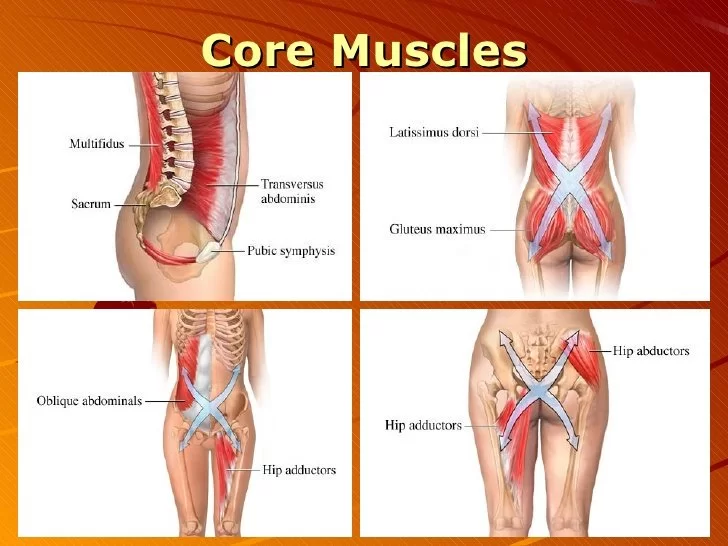
- Abdominal muscles
- Hip muscles
- Gluteal muscles
- Lower and upper back muscles
- Inner thigh muscles
The purpose is to be in total control of your body as you move. That needs to begin from your central core muscles and use the stability these muscles provide to smoothly control your arms, legs, and other extremities.
What is the powerhouse?
According to common belief, your core, often known as your powerhouse, includes muscles other than only your abdominals.
From the bottom of your rib cage to the bottom of your buttocks, it occupies the middle of your body. It contains the pelvic floor, glutes (sometimes known as the butt muscles), inner thighs, and lower back muscles.
Consider it as your body’s corset but without the restrictive quality. This site accommodates your organs, ideally helping them in their natural position and improving their functionality.
The powerhouse works in conjunction with your breath for maximum efficiency. rather than constantly gripping or bracing, try to maintain a balance of activation and relaxation to achieve flexibility.
What are the benefits of Pilates exercises?
Pilates is very convenient for everyone. While there are typical exercises you can do on the Pilates reformer, Pilates mat exercises do not require any tools at all. That means you don’t need to take Pilates classes or go to a gym to do them, and you can do a quick Pilates training right at home.
Fitting in your Pilates at home is also suitable and effective. Besides building strength, Pilates is also useful in increasing flexibility, improving your balance, and even enhancing your coordination and breath awareness. It is also a scalable exercise modality, meaning there are lots of Pilates exercises for newbies who are just getting initiated, as well as interpretations and progressions for the more advanced exerciser.
Some advantages are:
- Enhances flexibility
- Enhances core strength
- A demanding low-impact form of exercise
- Can enhance posture and stability
- This can be done with no tools
- Improves flexibility and range of movement
- Enhances muscular endurance and supports muscle tissue
- Can be performed after injury or as part of physical rehabilitation therapy
Pilates principles
There are six major principles for Pilates, which are essential for getting the most out of each workout.
- Centering: This is all about obtaining your awareness of the base of your body the area between your lower ribs and pubic bone. This place (your core) is the basis of all Pilates exercises.
- Concentration: Providing each exercise your full attention is key to yielding maximum results from each action.
- Control: Goal for total muscular control, going slowly and controlled.
- Precision: Focus on correct alignment and core engagement, striving for super special form.
- Breath: Coordinate your Pilates movements with your breath; one movement on the breath in, one movement on the breath out.
- Flow: Try to make each Pilates workout as fluid as possible, flowing with your breath.
What kind of training is Pilates?
‘Pilates is a low-impact flexibility and muscular strength and endurance training combined.
‘Pilates highlights correct postural alignment, core strength, and muscle balance. It is fantastic for ironing out muscular imbalances, injury rehabilitation, and injury prevention.’
There are many forms of pilates:
- Classic Pilates: The classic Pilates movements performed in the same series each time
- Mat Pilates: mat-based exercises
- Contemporary Pilates: A combination of classic and new Pilates exercises, done in varying series using a range of small pieces of tools.
- Reformer Pilates: A vigorous form of Pilates using a ‘Reformer’ to add resistance and challenge strength.
- Clinical Pilates: Injury and rehabilitation-specific movement, prescribed by physiotherapists.
‘I would suggest testing out the various forms to find out what utilize best for you.
Does Pilates count as training?
Pilates is the most absolute exercise and when done perfectly it is very difficult. As an activity, it counts as a muscle-strengthening movement. Plus, you can work the entire body through Pilates. It challenges your lower and upper limb and demands core muscles.’
Is Pilates safe during pregnancy?
If you are expecting, Pilates may be one of the most profitable ways to move your blossoming body. Not only is it safe, but it is the practice I strongly believe all pregnant females should contain in their fitness plan.’
Here are some of the advantages for mums-to-be:
- It supports muscles most impacted by pregnancy (like the abs, glutes, and pelvic floor).
- It is a low-impact activity.
- It can relieve back pain.
- It assists in keeping you mobile.
- It enhances balance.
It is very safe, yet very useful, and it means that many women can still feel the “burn” during their pregnancy, whilst knowing their babies and their health is not compromised.
If you did not practice Pilates before pregnancy, it is the perfect time to get started, and it is never too late.
How to get started:
- Speak to your doctor. It is always a good idea to talk with a healthcare provider before beginning a new workout routine. Pilates is a great choice for individuals with a wide collection of chronic medical conditions, but depending on your situation you may require to adjust your practice slightly. It is especially important to talk to a physician if you are hurt or recovering from surgery. Pilates can be a therapeutic practice, but initiating too early could make things worse.
- Make sure you have a qualified instructor. Even if you only perform mat exercises at home, you still need a skilled Pilates instructor. If you are doing these exercises for particular health issues then you must need a qualified trainer. One mark of a good instructor: is patience. When practicing Pilates in a group or one-on-one environment, Pilates advises that the movements start easy and gradually increase in difficulty. You can’t just dive in, your instructor must comprehend.
- Begin slowly: Even if you’re a fitness enthusiast, it’s important to begin your Pilates practice slowly and gradually before moving up to higher difficulty levels, even if you’re a fitness enthusiast. Because you’re teaching your body new movement patterns, you should prepare for some soreness. If you try to move too quickly, you run a chance of causing damage yourself.
- Do not assume using a mat is “easier” than using a reformer. There are advantages as well as drawbacks of Pilates, and not is simple. Both methods are frequently used in studio classes. When using a mat, your body is battling against gravity. Freeform Pilates can be harder on the back than using a reformer.” Bar also notes that although reformers can be purchased for home use, it’s important to work with an instructor to learn the correct alignment. As you exercise, they’ll watch you to make sure each movement is done safely and effectively.
- Do what’s right for you. It’s a prevalent misconception that Pilates can only be performed by wealthy and athletic people. The cost can be excessive, but if you search about it, you can frequently find great deals. As an example, purchasing sessions or class packages frequently reduces the cost of classes. Evaluate your level of fitness and degree of comfort when you select the exercise of your Pilates practice like a studio vs. home, solo vs. group, mat vs. reformer, etc.
Pilates vs. yoga
Well, they are both performed on a yoga mat (for the most part) but there are some key distinctions between the exercise protocols.
‘One of the major differences between Yoga and Pilates is that Pilates concentrates on relaxing tense muscles and strengthening others. Yoga is done to improve the flexibility of the body,
Both fields have great advantages. Depending on your plans. If you are looking to improve your core strength, Pilates is a great form of practice. It will help enhance deep core strength, muscle control & stability, posture, and coordination while improving muscular endurance.
‘However, if you’re looking to primarily improve flexibility and prefer to include a spiritual element to your training, then yoga may be more attractive to you.
Which are great Pilates core exercises?
The Pilates One Hundred, the single-leg stretch, and the roll-up are all excellent Pilates core exercises. There are also a lot you may not precisely be familiar with by name but may remember once you see them.
You can pick a few of these Pilates core activities to do as a warm-up for training Or you can incorporate some into your next workout as a way to target and work your core. And if you are looking for just a short movement session, you can choose a few you like and do them a couple of moments through to create a standalone practice. If you’re new to these activities, try doing a move for thirty seconds, working your way up to a minute.
Here we describe exercise to strengthen the core muscles.
Leg Circle
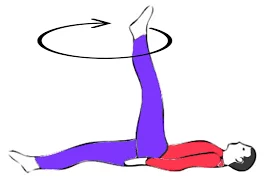
- To start this exercise palms of your hands should be facing down and you have to lie on your back.
- Your left knee should be bent, and the left foot should be flat on the ground. Make sure your right leg is fully extended and parallel to the ground.
- To circle back to your starting position, lower your right leg to the ground and out to the side. While keeping your lower back on the floor, enlarge the circle as much as you can.
- the circle in reverse.
- One leg at a time, finish all reps, then switch to the other.
Pilates One Hundred
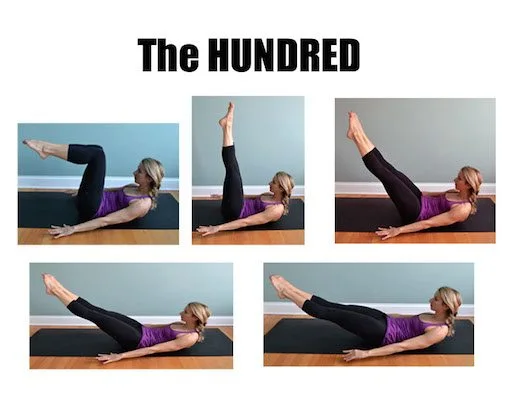
- To start Pilates hundred you have to take a supine lying position and place your arms by your side.
- Lift both legs towards the ceiling and bend them at the knee halfway down.
- Raise your head while stretching your long arms parallel to your body with your palms down.
- As you take five breaths in and five breaths out, pump your arms up and down.
- While maintaining the posture, repeat this breathing rhythm ten times.
Single-Leg Stretch
- Take a supine lying position.
- Put your hands on your shins, bend both knees towards your chest, and lift your head off the floor.
- While extending one leg at a time, switch sides.
- Throughout, maintain a flat lower back and a tight core.
Criss-Cross

- To start this exercise lie on your back with your face up. the act of raising both knees to the chest.
- Maintaining a wide angle at the elbows, place your hands on the back of your head. incline your head.
- Your left leg is extended as you bring your left shoulder to your right knee. Then, when you stretch your right leg, sag your right shoulder towards your left knee.
- Repeat switching sides.
Double Leg Stretch
- Bring both knees in close to your chest while lying face up. Put your hands on your knees and raise your head.
- Reach both arms aloft and extend both legs in front of you. While maintaining your lower back on the floor, attempt to stand with your legs as straight as you can. Pull your knees back towards your chest while circling your arms out and around your knees.
Pendulum
- To initiate pendulum exercise you have to take a supine lying position and put your arms by your side.
- Lift your feet off the mat and bend your knees over your hips.
- While keeping your lower back on the floor, let both knees fall to the right.
- Repeat on the opposite side, then get back to your starting position.
Scissor Kick
- Lie down with face-up.
- Put your right leg straight up and parallel to the ground. Curl your head up and place your hands behind your right leg, bringing it inward towards your face. Raise your left leg a couple of inches off the ground.
- By switching legs, you should move your left leg closer to you while leaving your right leg hanging loosely above the floor.
- Keep changing your legs.
Teaser
- Lie down with face-up. Lift your feet off the mat and bend your knees over your hips.
- Lift your head and shoulders off the mat while extending your legs and reaching your arms towards your feet. With your torso and legs, try to form a V.
- Hold for five breaths, then again bend your knees as you roll onto your back.
Roll Up
- Lie on your back with your feet flat on the floor and your arms lifted above your head.
- As you progressively raise your spine off the floor, starting at your shoulders and working your way down to your lower back, float your arms up until your wrists are exactly over your shoulders.
- Sit up straight and then proceed to fold your torso over your legs while maintaining a tight core. Reverse the action to fall back to the ground by rolling from your lower back to your shoulders.
Plank Leg Lift
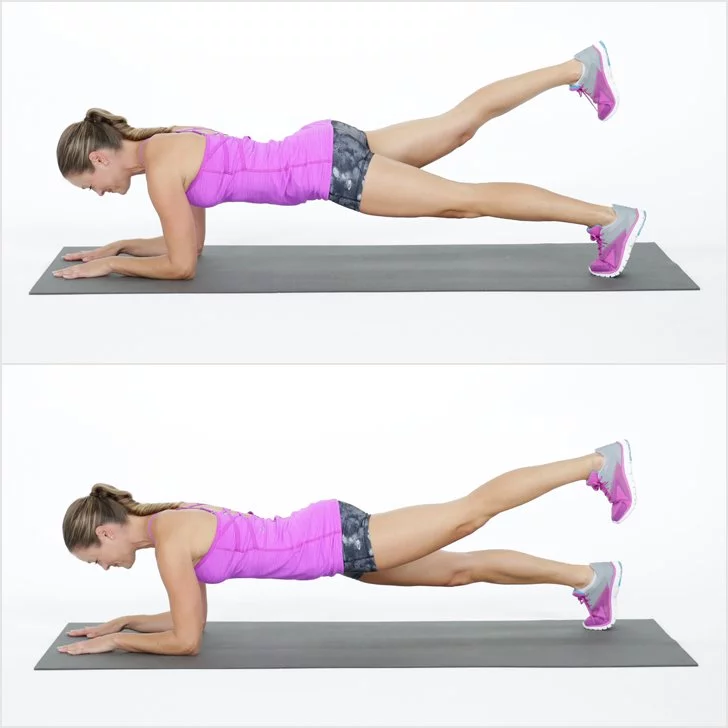
- Starting with your hands right beneath your shoulders, perform a high plank.
- Alternately, lift one leg as high off the ground as you can without going above shoulder level.
- To prevent swinging your hips, keep your quadriceps, butt, and core engaged.
Plank Rock
- Start on a high plank with your hands firmly beneath your shoulders.
- Rock your whole body forward a couple of inches toward your hands and then backward toward your heels.
- Throughout, keep your quads, butt, and core active.
Slow Motion Mountain Climber
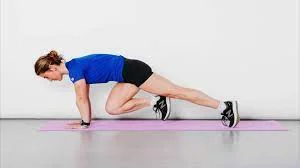
- Starting with your hands right beneath your shoulders, perform a high plank.
- One knee at a time, bring it closer to your chest.
- To prevent swinging your hips, keep your quadriceps, butt, and core engaged.
High Plank to Pike

- Start in a high plank position with your hands shoulder-width apart (or wider if that’s how you typically do push-ups), your shoulders stacked above your wrists, your legs stretched, and your abs tight.
- As you straighten your legs as much as you can, exhale to lift your tailbone towards the ceiling. If necessary, you can budge your knees to lower your heels to the floor. Return to the high plank by reversing the movement. One rep equals this.

Hip Dip
- Start in a side plank position, placing your left foot on top of your right, and your right hand directly beneath your right shoulder.
- Lift your hips back up after dipping them down towards the ground. Before moving to the left, repeat 10 times.
Bird-Dog
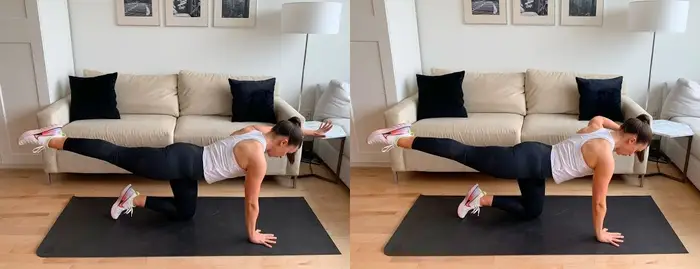
- Start on your hands and knees in a tabletop position, stacking your wrists under your shoulders and your knees beneath your hips.
- Extend your right arm forward and left leg back while keeping your back flat and your hips level with the floor. A foot against the wall behind you might be suggested.
- Return your arm and leg to the starting position while clenching your abs. One rep equals this.
- Repaint the other arm and leg after completing a certain number of reps.
Bird-Dog Crunch
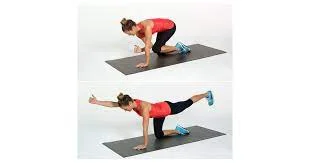
- Start on your hands and knees in a tabletop position, stacking your wrists under your shoulders and your knees beneath your hips.
- Extend your right arm forward and left leg back while keeping your back flat and your hips level with the floor.
- Now slap your foot against the wall in the back of you.
- At the midpoint of your body, squeeze your abs and bring your left knee and right elbow together.
- Then, do the opposite and extend your arm and leg once again.
- A rep is one. Repeat the other arm and leg after completing a certain number of reps.
Toe Tap
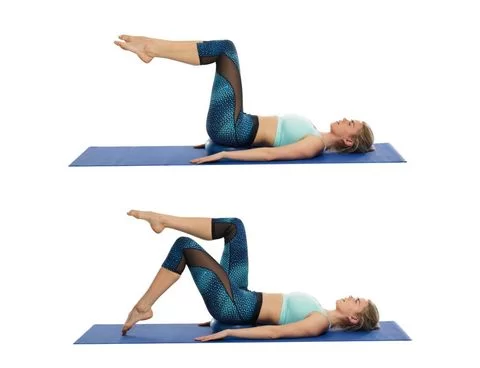
- With your feet flat on the ground and your arms by your sides, lie on your back.
- Your knees should be at a 90-degree angle. This is where everything begins.
- Bring your feet down gradually so that they can touch the ground. This is one repetition.
- Now, come back to the initial position and repeat.
Push-up
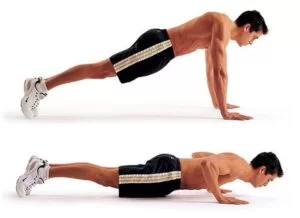
- To perform a push-up you are going to get on the ground on all four limbs, placing your hands slightly wider than your shoulders. Maintain a slight flexion in the elbows rather than locking them out. Stretch your legs back so you are balanced on your hands and toes, your feet hip-width apart. Once in this position achieve.
- Tighten your abs and pull your core by pulling your belly button toward your spine.
- Breathe in as you slowly flex your elbows and lower yourself to the ground, until your elbows are at a ninety-degree angle.
- breath out while contracting your chest muscles and pushing back up through your hands, returning to the initial position.
Bridge
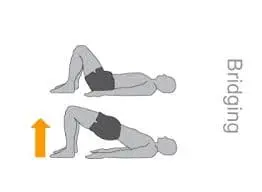
- Lie on your back with your knees flexed, heels in line with your bottom, and your arms relaxed by your side. Take a deep breath in, and as you breathe out flatten your lower back to the ground as though you are raising your tailbone to the roof.
- Your head should feel relaxed so make sure you are not pushing your head down to the bottom. You should be aware of your buttock muscles working to hold the raise.
- When you are ready to breathe in, return down to the mat one vertebrae at a time starting from the upper back, working your way down through the mid back then finally the lower back. If during the exercise you feel a twinge in your hamstring muscles, walk your feet a little closer to your hips.
Kneeling sidekick
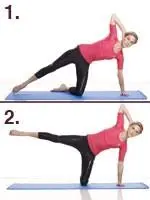
- To start this exercise take a Kneeling position and bend the torso to the side. Put one palm on the mat, with the fingers pointing away from the knee. Put the other hand behind the head, with the elbow flexed and pointing toward the roof. Raise the top leg (the leg farthest from the support arm) to about hip height.
- Breathe in and raise your leg forward. Hold for two seconds then
- Breathe out with the raised leg backward. Repeat the series five times. Do the same on the opposing leg.
Single-leg kick

- Lie down on your chest on a mat, and hold your palms close together near your chest, in a push-up position.
- Slide your elbows under your shoulders, and bring your fists jointly to connect them. That supplies a proper stretch on your forearms.
- Place your legs together, and provide your pubic bone is pushed on the mat, and slightly raise your abdominal muscles.
- Flex your right leg backward from the knees, where your heels are attempting to reach your buttocks. However, it will be one swift motion. pulse twice at the top of the movement before moving to the neutral position.
- Do it alternatively on both legs for at least ten to 20 reps.
Double-leg kick
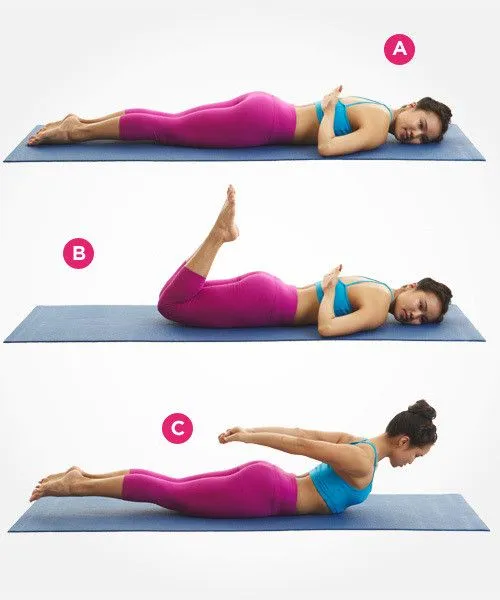
- Lying on your belly, extend your legs and contract them together. Lock your fingers behind your back with your arms rested and your face resting on one cheek.
- Exhale and bend both of your legs, then pulse your feet in the direction of your buttocks.
- Inhale, straighten your arms and legs behind you, lift your upper back, and position your head in the middle. Reduce your body’s height, place your face on the cheek on the opposite side, and repeat.
Control Balance
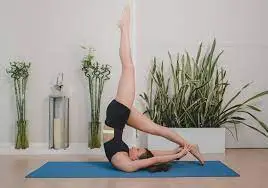
- To begin this exercise you have to lie on your back with your knees flexed and pointed towards the roof. Arm extended over your head.
- Carry both legs up to a ninety-degree angle and then extend them straight out at an angle.
- Get your legs back over your body so that they are parallel to the floor and hold for five seconds.
- Now holding your legs straight bring them up and point them straight towards the top.
- Maintain this position and bring your right leg down to your hands gradually and then slowly back up.
- Then switch and carefully lower and raise your left leg. 10 to 15 repetitions of back-and-forth alternation.
The saw
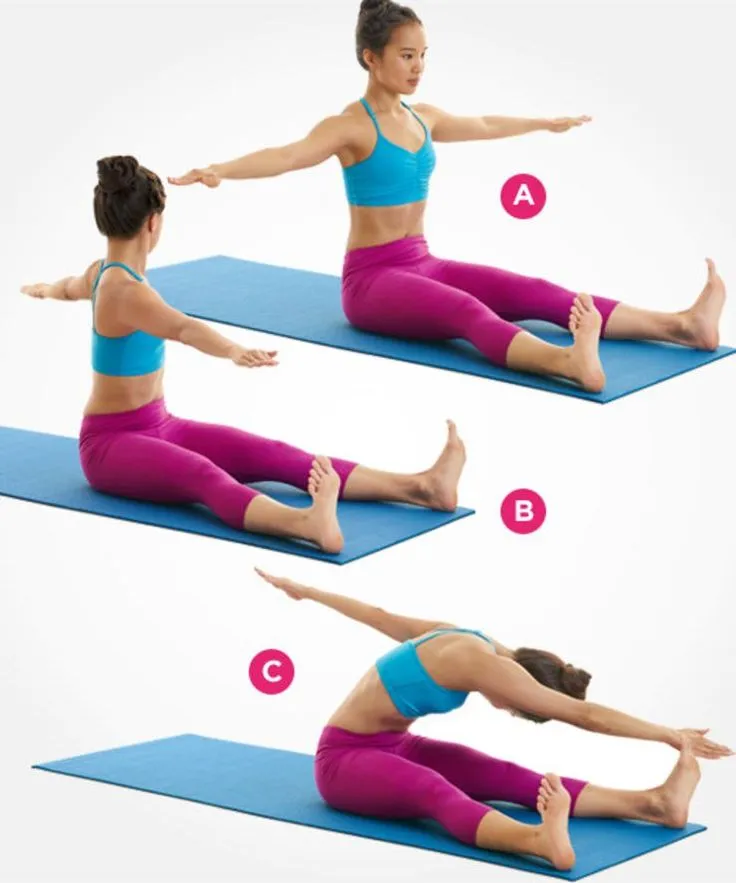
- Legs apart and feet flexed while sitting tall. Extend your arms to the sides and up in the air.
- Take a breath, turn to the right, then dive forward while reaching out with your left arm to try to contact your right foot. Twist to the left, then return to the center and repeat. Do this on both sides for 30 repetitions.
The swan dive
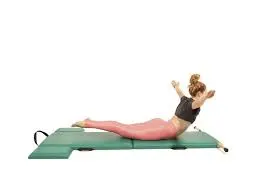
- Your hands should be on the mat between your shoulders and your head while you are lying on your stomach with your legs joined.
- To lift your upper torso off the floor, extend your arms straight front. Your torso should have an arc to it.
- As your body moves forward while keeping its arc shape, let go of your arms straight out. Your legs will need to rise from the pad behind you as a result. Make sure your glutes and inner thighs are tightened.
The scissors
- To start this exercise take a supine lying position on the mat with your head and shoulders elevated.
- Both legs must be raised towards the ceiling with your feet plantar-flexed.
- Right leg extended towards the body in the air.
- While you do this, maintain gently onto the leg and keep your abdominals well connected.
- Breathe in and switch legs.
- Breathe out and repeat the movement with your left leg.
The bicycle
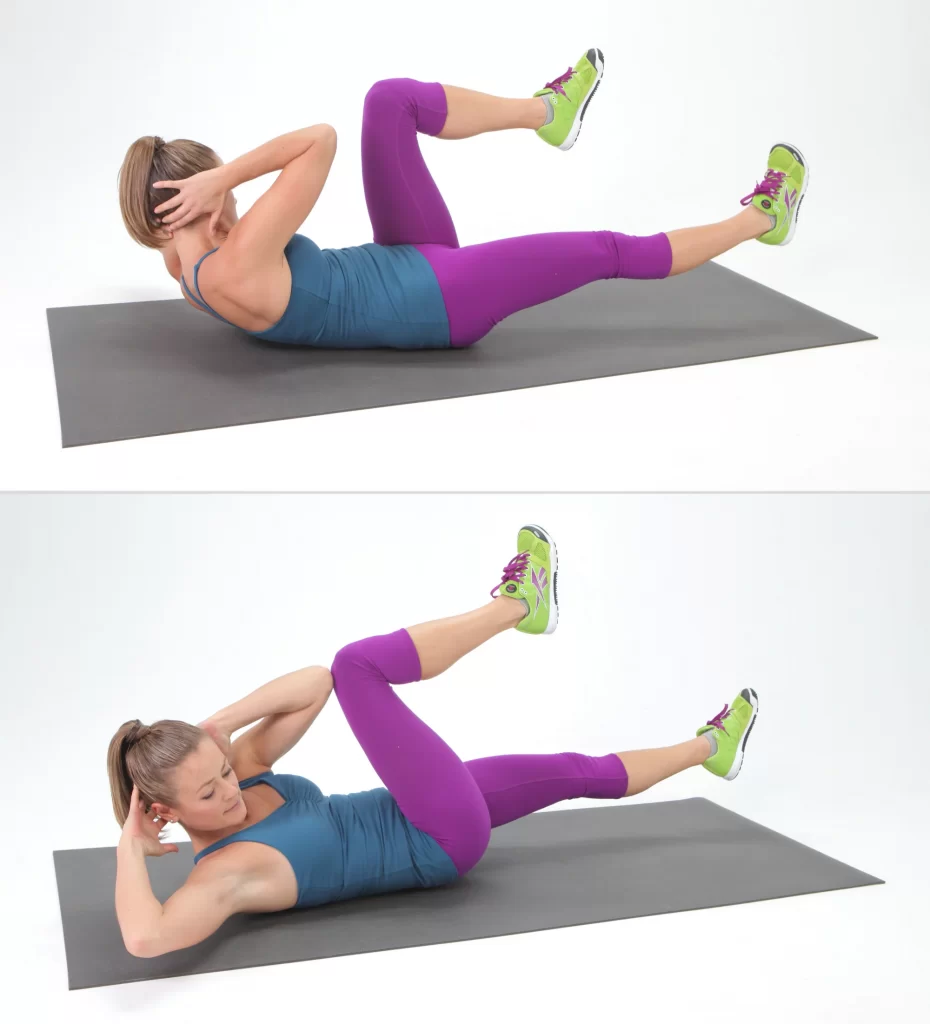
- lie down on the mat and get your knees towards your chest. Place your arms beside you and extend your legs towards the roof.
- Next, raise your legs overhead and balance yourself between the shoulder blades. Make sure you are not putting pressure on your neck.
- Place your hands behind your hips to support your body, and bring your pelvis to put pressure on your hands.
- Your legs will come just backward but maintain an angle of 45 degrees.
- Now, the idea is to do reverse cycling. Paddle your right leg towards the direction of you and the mat. Your left leg glides in the direction of the mat while your right leg rises once more.
- At least ten repetitions should be performed for each leg while continuously changing legs.
- When you’re finished, slowly return your legs to the mat while maintaining your hip position to prevent any collisions.
The spine twist
- Seat on the ground with a straight spine. Ensure that your core muscles are tight and that your shoulders are not slouching. This will supply proper support for your upper body.
- Stretch your arms out to your sides and extend your legs forward until your fingertips are parallel to your shoulders.
- Once you have come to this position, you can start the training.
- Turn your upper limb to one side, with your spine becoming taller as you twist.
- Return to neutral and repeat on the opposite side once you feel the stretch in your abdominal muscles. Continue to do this numerous times per side.
The Boomerang

- Beginning in an upright seated position, extend your legs in front of you, heels twisted. Your hands should be flat on the mat as you hold your arms by your sides.
- Cross your left ankle over your right. Breathe in when you sit up straight and pull the tummy muscles in.
- Roll your torso back one vertebra at a time while exhaling, keeping your legs extended, until your hips and shoulders are in line. With your palms facing down, your arms should be outstretched flat on the mat.
- Take a deep breath in and spread your legs wide with your toes brushing the edge of the mat. Alternate legs such that the left ankle now sits over the right. You quickly breathe while opening and closing the legs to do this.
- Once your legs are at a 45-degree angle to the floor, exhale and roll your torso back up. Put your ankles back together in the crossing position and join your hands behind your back.
- On an outbreath, lower your knees back to the floor and tilt your torso forward until your head meets your chin. Straighten out your arms so that they are behind you.
- Release the grip, circle your arms forward, and relax into the stretch. Repeat on the opposite side after releasing from the stretch.
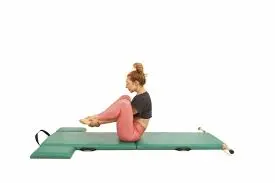
The seal
- Get down on the ground with your knees slightly bent. Place your hands on the outside of your ankles, drawing them in towards your center.
- To balance on your hands and feet, push through your legs and lift your arms overhead.
- Rolling up onto your toes requires you to draw your stomach in firmly and curve your lower back until you feel balanced.
- Scoop your abs up to create a C-curve with your torso. Keep your focus on your feet at all times. Your feet should be two inches away from the mat.
- Clap your feet three times as you start.
- On an inhalation, roll back onto your shoulders while starting the motion with your lower abdomen (not your neck). Clap across your legs three more times when you reach the top.
- Breathe in to help you roll back up, use both your exhalation and your deep abdominal muscles.
- As you roll forward to your initial position, point your feet at the mat in front of you. To find equilibrium, hold for a second.
- Repeat 4 to 6 times. To hold the rhythm of the movement, clap your feet should be together.
The rocking
- Lie on your tummy. breath in flexed the knees, and reached back with the arms, taking hold of the ankles and lifting the torso and legs into an arch.
- Breathe out rock forward.
- Breathe in and rock backward, lifting your chest and pulling back from your ankles. Hold your navel pressed into your spine.
- Rock back and forth five times. Release your ankles to finish, then sit back on your heels with your arms out in front of you.
- Position your forehead on the mat. This position is similar to a child’s pose in Yoga.
Precautions are taken care of during the workout:
There are examples where people feel dizzy while accomplishing the workout, especially during weather transitions. In such cases, you must inform your instructor to modify your form. If you are practicing all by yourself, follow these tips:
- If your neck pains during exercising put a cushion under the neck. You can also activities with a pilates block to support your neck.
- If your back is having issues, put cushions under your back.
- If you are having knee problems, use an elastic band.
These devices are easily available and extremely useful, especially for those who are fresh to Pilates or people with back, neck, knee, or joint issues. For you to avoid injuring yourself, it is essential to take precautions. You are accomplishing this much hard work for your body so do not cause any trouble to it.
When you should not perform this Pilates exercise?
Chronic Medical disease:
- Certain chronic medical conditions
- Such as heart disease
- High blood pressure
- Diabetes
This person may need changes to certain pilates exercises or even complete avoidance of certain activities.
FAQ
For what Pilates is most effective?
improved flexibility, increased muscle strength and tone, particularly of your tummy muscles, lower back, hips, and buttocks (the ‘core muscles’ of your body) balanced muscular strength on bilateral sides of your body. Gain better control over your back and limb muscles.
Is Pilates a good way to reduce Weight?
Unlike many high-intensity exercises, Pilates does not burn a substantial amount of calories, but investigations have found that it can decrease body weight. A 2021 analysis found Pilates to effectively lower body weight and body fat percentage in participants with overweight or obese.
Does Pilates assist in reducing belly fat?
While you will certainly burn calories, reducing tummy fat from Pilates is a mythology. You can not spot decreased fat anywhere in your body, regardless of the exercise.
Which is better yoga or Pilates?
If you want to improve your strength and flexibility, Pilates can be the most suitable choice. If you want to enhance your overall wellness, you may choose yoga.
Can Pilates decrease thigh fat?
You can do several pilates movements to perform on your thigh fat. Pilates side leg sequence of 5-10 exercises that are done by lying on the side of the body. They target all the muscles of the lower limb and tone and shape them.
Can I perform Pilates at home?
You do not need to go to Pilates studios or invest in a Pilates ring, an at-home reformer, or a Wunda chair to make your Pilates conditioning more challenging. Balancing up your Pilates exercises can be done at house with equipment such as dumbbells, ankle weights, and resistance bands.
Can we try Pilates during periods?
Whether it is the first day of your period or the last, you can perform Pilates during your periods.
Is Pilates sufficient to get in shape?
If muscle building is your purpose, Pilates will help you, but you may be required to add in weight training as well. While capable of building some muscular strength and endurance, Pilates is not hard enough to build muscle size or strength beyond a fundamental level.
Is thirty minutes of Pilates a day enough to reduce weight?
A 155-pound person burns roughly 240 calories in 30 minutes of doing beginner-level Pilates, according to the American Council on Exercise. Pilates can assist you in building muscle. Muscle tissue burns more calories than fat tissue, so strengthening muscle with Pilates can assist you in burning more calories and reducing weight.
What are the benefits of Pilates control balance?
Control and balance Pilates movements on the mat emphasize confronting the deep core muscles. By targeting the transverse abdominis, multifidus, and pelvic floor muscles, practitioners develop a powerful foundation, leading to enhanced spinal alignment, posture, and overall stability.
What are the main three benefits of Pilates?
enhanced flexibility.
improved muscle strength and tone, particularly of your abdominal muscles, lower back, hips, and buttocks (the ‘core muscles of your body)
balanced muscular strength on each side of your body.
improved skeletal muscle control in your back and limbs.
What are the side effects of Pilates?
pilates group participants were made aware of potential negative effects such as weakness, breathlessness, headaches, dizziness, and muscle soreness.
Who should not perform Pilates?
Chronic Medical disease: Certain chronic medical disorders, such as heart disease, high blood pressure, or diabetes, may need modifications to certain pilates activities or even complete avoidance of certain movements.
References
- Menzies, R. (2021, April 26). Core Galore: 15 Pilates Exercises to develop your powerhouse. Healthline.
- CPT, A. M. W., & CPT, C. S. (2022, March 3). 17 Amazing Pilates Exercises that work your Core—And You can do right at home. SELF.
- Milena. (2023, September 6). Pilates 101: What it is and Health Benefits. Cleveland Clinic.
- Buick, K., Fargo, M., & Wilkins, B. (2023b, September 8). What is Pilates?: A complete beginners’ guide, inc. 34 exercises, benefits + 15 best online classes. Women’s Health.
- 5 benefits of Pilates that may convince you to add it to your workout regimen. (n.d.). Houston Methodist on Health.

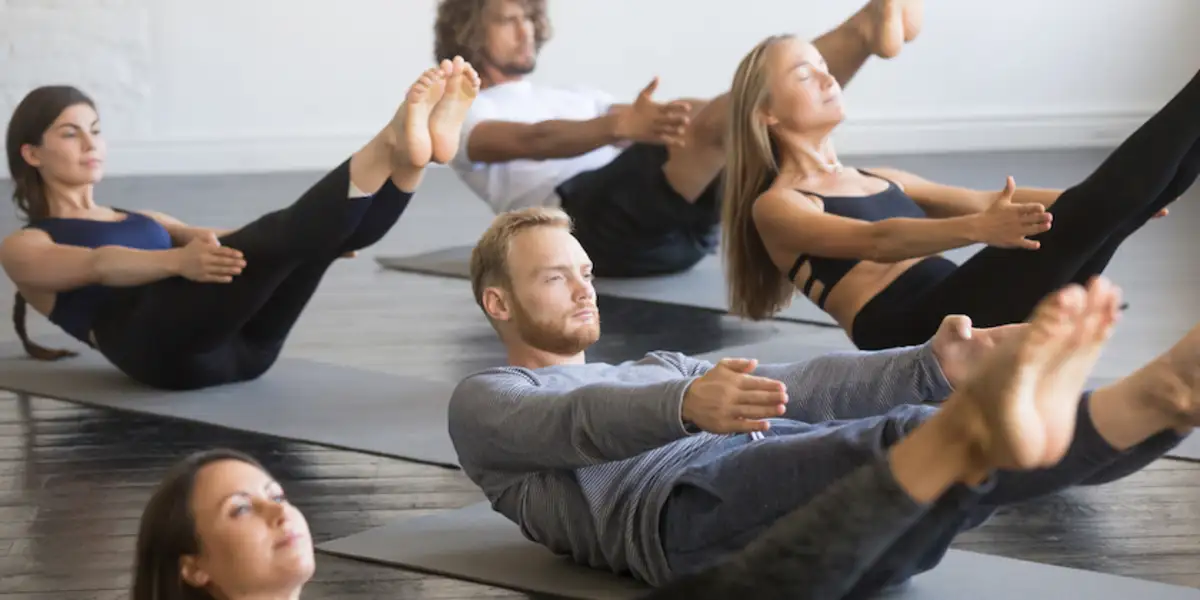
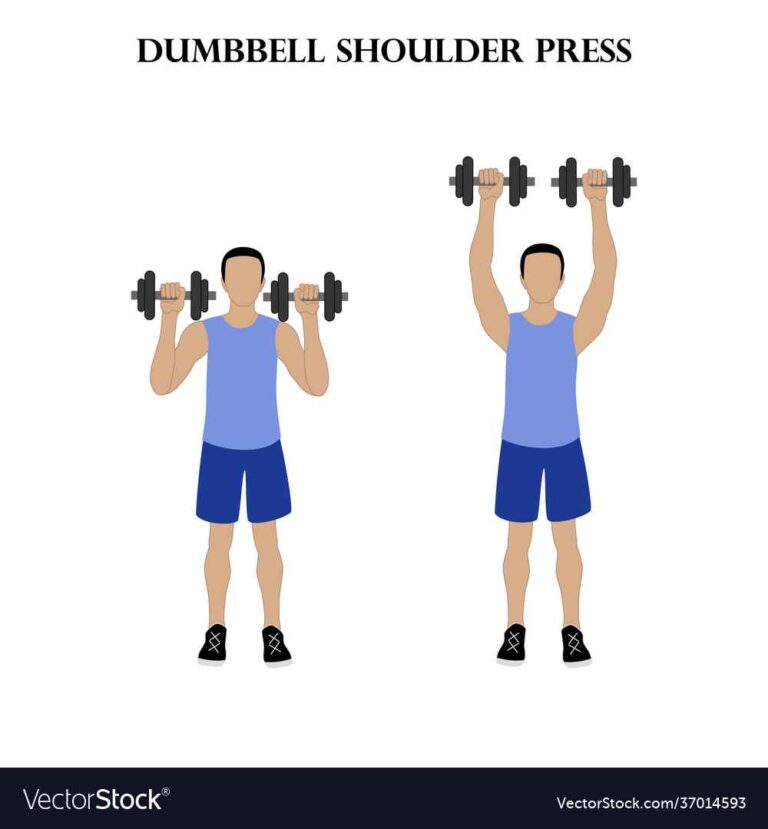
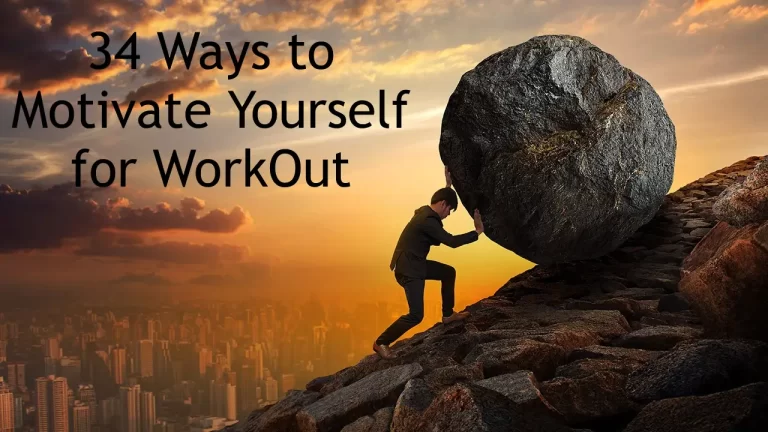
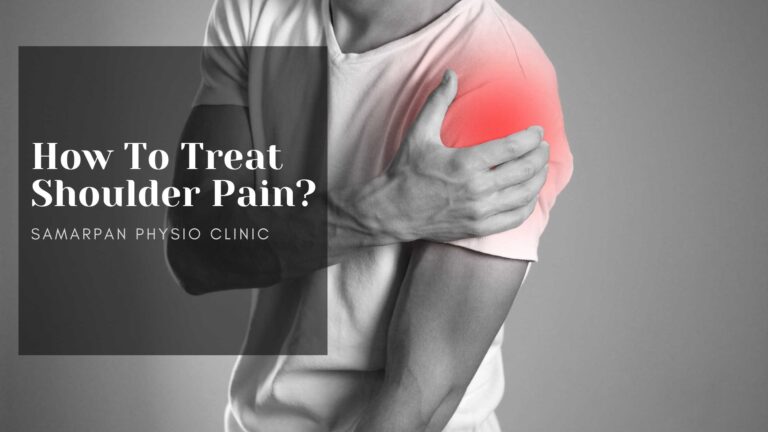
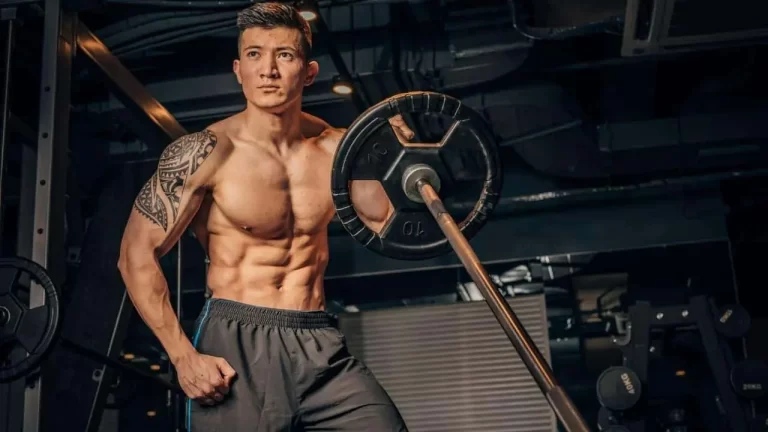


6 Comments